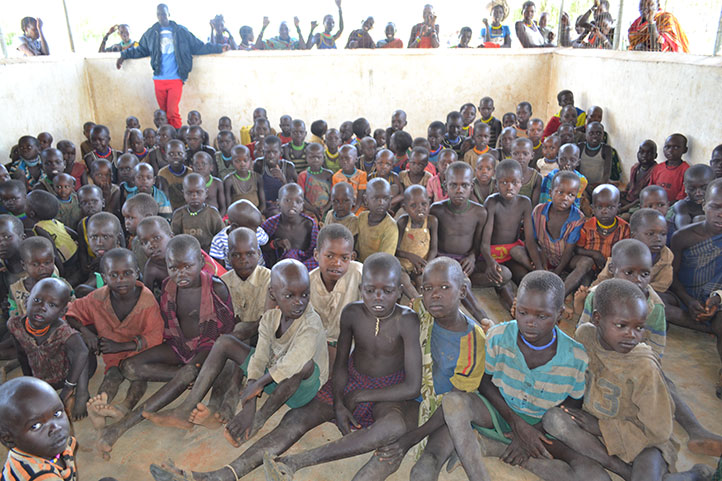
At a few minutes to midday on April 21, the bell goes off at Namorulem Mobile Abek (Alternative Basic Education for Karamoja) centre in Nakakapiripirit district and children walk from nearby homes to the centre.
It is peculiar that nursery school children – nursery school education is provided at Namorulem – are starting school at midday. Equally peculiar is the fact that the school children are not dressed in uniform.
Some boys have tied sukas – the type herders and Maasai people wear – around their waists while the girls are wearing beads around their necks. Suffice to say that the children look colourful.
“It is the cultivation season, so we start school at midday; the children first have to attend to the gardens in the morning,” explains Rufino Kosike, the headteacher of the Namorulem Mobile Abek centre.
FLEXIBILTY
That is the type of flexibility Abek centres offer. The children’s attire, particularly the boys’, can also be explained by Kosike’s statement. Because the children stream into school from their chores, the boys, who work as cattle herdsmen, walked into class in their work attire, the suka.
In class, the children, some of whom look chubby and healthy, are taught basic literacy and numeracy. To learn their vowels, they sing a song in Ng’akarimojong.
Anyukuta na, ebala anyukuta na A
Anyukuta na, ebala anyukuta na A
Anyukuta na , ebala anyukuta na E
Anyukuta na , ebala anyukuta na E
They sing on and on, until they have mentioned all the vowels. The children also learn numbers one to six. Kosike is proud of the strides being made in educating Karamoja’s children through the Abek education system.
“Our first graduates [from the Abek centre] are in S3,” Kosike relates. He adds: that, “They started school in 2009 at this centre when it was opened. When they joined primary school, the teacher realised that they were clever and took them to P3 straight away.”

Alfred Chemonges, the sports officer for Amudat, (speaking on behalf of the area Education office) echoes Kosike, saying that “When they [children from Abek schools] go to school, they are taken straight to P3. The Abek centres are helping to boost education in Karamoja.”
Chemonges adds that Karamoja is unique. Where education is valued in other parts of the world and in some parts of Uganda, the Karimojong value their animals more. For years children have preferred to look after cattle instead of going to school.
“Education was perceived negatively previously. It was looked at as a long-term liability and only the stupid boys, the ones who lost cattle in grazing fields, were allowed to go to school. It was also said that the girls who went to school became ‘spoilt’ and no one would want to marry them. Yet marriage meant [valued] cows for a family,” Chemonges says.
To make education suitable, Abek was introduced in Karamoja. Mobile Abek made education even more accessible because with this kind of system, the school followed the herdsmen to the grazing fields, where they would get an education.
“We have surveillance systems which inform the education systems where the children are grazing their animals from,” Chemonges says. “Teachers get this information and follow their children [pupils] there.”
ATTITUDES CHANGING
Alice Aliat, a resident of Nakapiripirit district, is growing old and she is aware of it. In her old age, she wants to spend some of her time being read for. As such, she sent her daughter, Ngiro, to the Namorulem Abek centre; Aliat says that Ngiro does not have a second name because she is not baptised.
“I want her to learn to read and write so that she will read for me in my old age,” Aliat says of Ngiro.
Aliat isn’t the only parent to want an education for her daughter. In Tilwo Ngwiny village, Karita sub-county in Amudat district, parents whose children were evicted from Naporokocha Abek centre are unhappy that their children’s education was compromised. Some have resorted to taking their children across the border to Kenya.

“It seems Kenya values education more than Uganda. We have taken our children there [following the eviction],” says Daniel Nakoti, the chairman of the school committee for Naporokocha Abek centre.
The increasing enrolment also explains rising interest parents have in education. At Namorulem, 127 pupils enrolled for education in 2015, 29 more than in 2014. Prior to that, 55 children had enrolled for school in 2013.
CHALLENGES
The increasing enrolment figures are not only a result of increasing interest in education. Chemonges and Kosike say that food and items such as cups attract children to school.
Abek centres are also sometimes too far away from children’s homes, so that children fail to enroll in school. Early marriages have also been known to disrupt girls’ education; during some seasons, even attendees of mobile Abek have to study from permanent Abek centres.
Some children study under trees, where they lack basic scholastic materials. However, some of these children, who have gone through the Abek system, perform well in national exams, according to Moses Kasaija of the Save the Children.
Kasaija is Save the Children’s regional manager for eastern Uganda; Save the Children is part of the NGO efforts geared towards supporting Abek centres.
Kasaija says some of the best students from Kalotom primary schools and Lokodiokodioi primary schools in Napak were products of the Abek system. One of them, Mark Aboka, was the best pupil in Kalotom, obtaining aggregate 9, in the last primary leaving exams.
FRENCH VERSION


